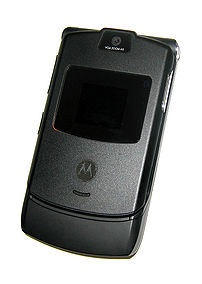I spend a lot of time stressing over why Web sites are too difficult to use, and that’s time well spent, of course, because we need to make it easy for our customers if we want them to pick us. But we need to also devote the same slavish attention to making our products easier to use. The latest product that makes me want to scream “FAIL!” is the cell phone, or at least some cell phones. Why are they so stupid when it comes to how they handle charging their batteries? It seems as though they are not designed to work the same way that people expect to use them, which is a basic part of building a following for your product. And that kind of mismatch is always an opportunity for someone smart.

Image via Wikipedia
My frustration stems from my daughter’s cell phone. We’re a five cell phone house and there’s always a problem with the battery for my daughter’s Motorola RAZR. We’ve replaced the battery, the charger, and even the phone (all more than once), and still her phone stops holding a charge after a few months each time.
Each time we troop down to the Verizon store for our cattle-car wait on line, we are told the same thing: You should only charge a cell phone battery when it needs it. Don’t leave it plugged in overnight. Don’t charge it every day. Doing those things just wears out the battery so it won’t hold a charge.
Now this, my friends, is not how people use cell phones–especially not teenage girls. They have their cell phone on and in use anytime their heads are not on a pillow and they want the phone to have a full charge every morning. So, there’s a disconnect between the way we use our phones and how we are expected to take care of them.
At first, I was resigned to this. Hey, if that is all that battery technology can do, then I guess we just need to adjust to it. But then I noticed how my electric razor works.
My razor is used once a day and then sits in its charger for 23 hours waiting to be used again. That seems like a lot tougher problem for an engineer to solve than the cell phone. And I would expect that, because the razor cost less than my cell phone and likely has a dumber chip in it than my cell phone, that anything my razor can do, a RAZR should be able to do.
So why isn’t a RAZR smarter than a razor? I can’t figure it out. My razor charges itself and then “conditions” the battery at various points during the day to avoid the problems of overcharging. I believe that laptop computers do the same thing now. Why can’t phones do it?
Maybe this is a problem that affects only the RAZR, but the Verizon people did not tell us, “For your phone, this is what you have to do.” They instead made it sound like every blessed cell phone has this same battery-mashing tendency, and that if you don’t do as they say, you might get lucky with your particular phone, or you might not.
To me, this is a very basic function of the phone that should be addressed before we all worry about how to update Facebook on our on-screen QWERTY keypad with tactile feedback.
And what about those “be green” commercials that say that when you leave your charger plugged in, it’s still sucking power? That one I can’t figure out, but I just want the engineers to wake up and make cell phones that work the way real people do. Real people charge their phones overnight–every night. Real people leave their chargers plugged into the wall when they detach their phones. Real people want their phones working all the time that they need them and don’t need a complex set of instructions on how to make that happen.
What about your product? When’s the last time you haunted your customer service department to see what people are complaining about? If you aren’t fixing your customer dissatisfiers, then you are just waiting for your competitors to do it.

![Reblog this post [with Zemanta]](http://img.zemanta.com/reblog_e.png?x-id=d454fb17-d36d-4b6f-86ad-44ee9f223ea4)

